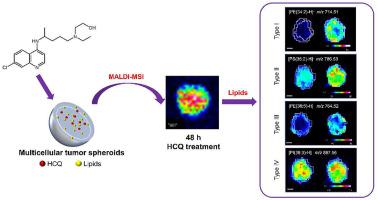Analytica Chimica Acta ( IF 6.2 ) Pub Date : 2021-09-01 , DOI: 10.1016/j.aca.2021.339011 Yanyan Chen 1 , Tao Wang 2 , Peisi Xie 1 , Yuanyuan Song 1 , Jianing Wang 1 , Zongwei Cai 1

|
Three-dimensional (3D) multicellular tumor spheroids (MCTS) that mimic the complex tumor microenvironment provide a good platform for in vitro study of drug and endogenous metabolites. Hydroxychloroquine (HCQ) has shown anti-tumor activity in a variety of tumor models. However, the effect of the drug on the alteration of lipid metabolism spatial composition and distribution in the MCTS model is not clear. Herein, we utilized matrix-assisted laser desorption/ionization-mass spectrometry imaging (MALDI-MSI) in the analysis of A549 lung cancer multicellular spheroids to investigate the in situ spatial distribution of HCQ and its effect on lipid metabolism. We have successfully observed the spatial variations of HCQ in the inner region of the spheroid at different drug-treated time points. The MSI results also demonstrated that HCQ treatment altered the spatial composition of lipids in the inner and outer regions of treated spheroids. Furthermore, the lipidomic results showed that the identified phosphatidylcholines (PC), lysophosphatidylcholines (LPC), phosphatidylethanolamines (PE), lysophosphatidylethanolamines (LPE), phosphatidylinositols (PI), ceramides (Cer), glucosylceramides (CerG), and diglycerides (DG) were significantly up-regulated, and phosphatidylglycerol (PG) and triglycerides (TG) were remarkable down-regulated. MSI method combined with LC-MS/MS profiling of endogenous metabolites can obtain more detailed information about how spheroids respond to drug and spatial distribution information, thus fostering a better understanding of the relationship between drug-altered lipid metabolism and cancer microenvironment.
中文翻译:

质谱成像揭示了多细胞肿瘤球体中脂质代谢物的改变,以响应羟氯喹
模拟复杂肿瘤微环境的三维 (3D) 多细胞肿瘤球体 (MCTS)为药物和内源性代谢物的体外研究提供了良好的平台。羟氯喹 (HCQ) 已在多种肿瘤模型中显示出抗肿瘤活性。然而,药物对MCTS模型中脂质代谢空间组成和分布改变的影响尚不清楚。在此,我们利用基质辅助激光解吸/电离质谱成像 (MALDI-MSI) 分析 A549 肺癌多细胞球体来研究原位HCQ 的空间分布及其对脂质代谢的影响。我们已经成功地观察到 HCQ 在不同药物处理时间点球体内部区域的空间变化。MSI 结果还表明,HCQ 处理改变了处理过的球体内部和外部区域中脂质的空间组成。此外,脂质组学结果表明,鉴定出的磷脂酰胆碱 (PC)、溶血磷脂酰胆碱 (LPC)、磷脂酰乙醇胺 (PE)、溶血磷脂酰乙醇胺 (LPE)、磷脂酰肌醇 (PI)、神经酰胺 (Cer)、DG 葡萄糖苷神经酰胺 (C显着上调,而磷脂酰甘油(PG)和甘油三酯(TG)显着下调。



























 京公网安备 11010802027423号
京公网安备 11010802027423号